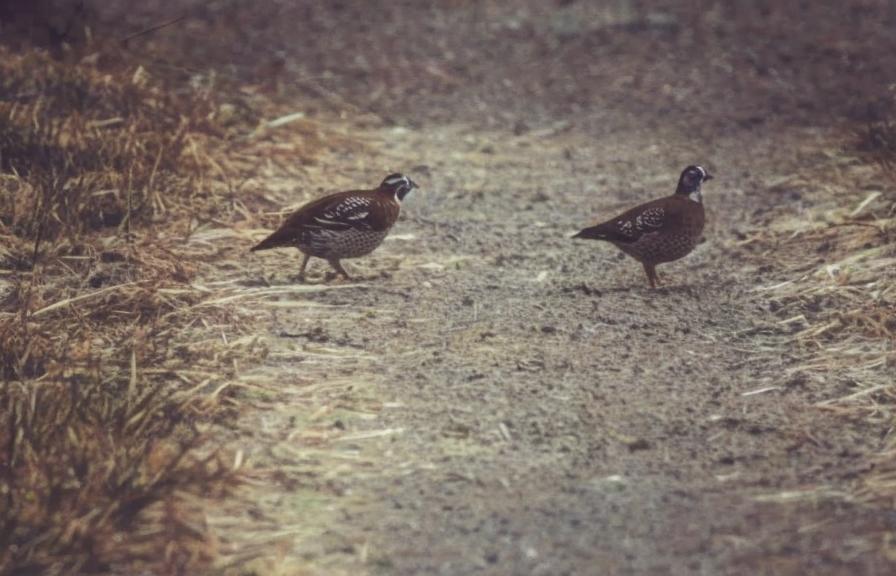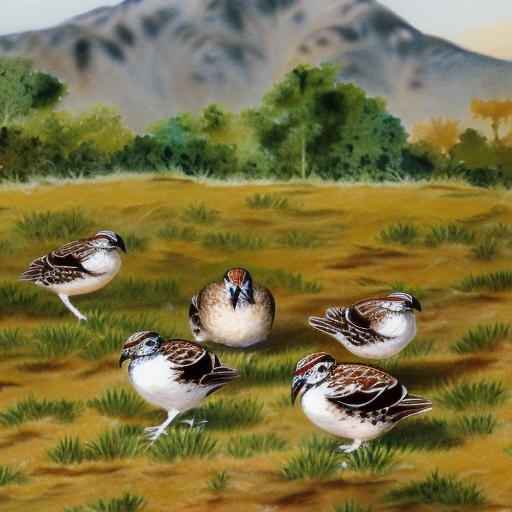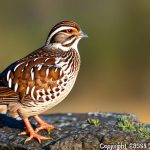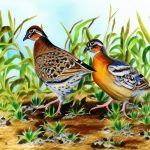The Bobwhite Quail, also known as the Northern Bobwhite, is a small ground-dwelling bird native to North America. They are popular game birds and are often raised for their meat and eggs. Bobwhite Quail are known for their distinctive call, which sounds like “bob-white” and can be heard throughout their natural habitat. These birds are known for their social nature and are often found in coveys, which are small groups of birds that forage and roost together. Bobwhite Quail are omnivorous and feed on a variety of seeds, insects, and small fruits. They are also known for their ability to adapt to a wide range of habitats, from grasslands and agricultural fields to brushy areas and open woodlands.
Bobwhite Quail are sexually dimorphic, meaning that males and females have different physical characteristics. Males are typically more brightly colored with a white throat and bold black and white markings on their face, while females have a more subdued appearance with brown and buff-colored feathers. These birds reach sexual maturity at around 16 weeks of age and can lay up to 12 eggs in a clutch. Bobwhite Quail are known for their strong maternal instincts and will fiercely defend their nests and chicks from predators. Overall, these birds are hardy and adaptable, making them an ideal choice for small-scale poultry production.
Key Takeaways
- Bobwhite quail are small ground-dwelling birds native to North America, known for their distinctive “bob-white” call.
- When selecting breeding stock, look for healthy, active birds with good body conformation and strong genetics.
- Creating the ideal breeding environment involves providing ample space, proper nutrition, and a stress-free setting for the quail.
- The breeding and incubation process requires careful monitoring of egg production, proper incubation conditions, and attention to hatching and chick care.
- Caring for bobwhite quail chicks involves providing warmth, proper nutrition, and a clean, safe environment for growth and development.
- Health and disease management is crucial for maintaining a successful quail breeding operation, including regular health checks and disease prevention measures.
- Marketing and selling bobwhite quail involves identifying target markets, promoting the quail’s unique qualities, and ensuring compliance with regulations for selling poultry.
Selecting Breeding Stock
When it comes to selecting breeding stock for Bobwhite Quail, there are several important factors to consider. First and foremost, it’s essential to choose birds that are healthy, vigorous, and free from genetic defects. Look for birds that are active, alert, and have bright eyes and clean feathers. It’s also important to select birds that conform to the breed standard, with males exhibiting the characteristic white throat and bold facial markings, and females displaying the appropriate coloration and markings. Additionally, consider the birds’ temperament, as you’ll want to breed from individuals that are calm and easy to handle.
Another crucial consideration when selecting breeding stock is genetic diversity. Inbreeding can lead to a host of health and reproductive problems, so it’s important to choose birds from different bloodlines to maintain genetic diversity within the flock. This will help ensure the long-term health and vitality of your quail population. Finally, consider the birds’ productivity and reproductive performance. Look for birds that have a history of laying large clutches of eggs and successfully raising healthy chicks. By carefully selecting breeding stock based on these criteria, you can establish a strong foundation for a successful Bobwhite Quail breeding program.
Creating the Ideal Breeding Environment
Creating the ideal breeding environment is crucial for the success of a Bobwhite Quail breeding program. These birds require a habitat that mimics their natural environment, providing them with the space, shelter, and resources they need to thrive. When it comes to housing, consider building or purchasing a spacious aviary or pen that provides ample room for the birds to move around and engage in natural behaviors like dust bathing and foraging. The enclosure should also offer protection from predators and the elements, with secure fencing and adequate shelter from wind, rain, and extreme temperatures.
In addition to providing a suitable living space, it’s important to furnish the breeding environment with appropriate nesting sites and materials. Bobwhite Quail prefer to nest on the ground in concealed locations, so provide plenty of low-lying vegetation, brush piles, or artificial nesting structures for the birds to lay their eggs. Fill the nesting areas with soft, dry bedding material such as straw or grass to create a cozy environment for incubating eggs. Finally, ensure that the breeding environment offers a varied diet of seeds, insects, and vegetation to support the birds’ nutritional needs. By creating a well-designed breeding environment that meets the physical, behavioral, and dietary requirements of Bobwhite Quail, you can promote successful breeding and healthy chick rearing.
Breeding and Incubation Process
The breeding and incubation process for Bobwhite Quail begins with introducing males and females into the breeding environment during the spring months when they reach sexual maturity. It’s important to maintain a proper sex ratio within the flock to prevent aggression and ensure successful mating. A ratio of one male to every three or four females is generally recommended to minimize competition and stress among the birds. Once the birds have paired off and begun mating, the females will lay their eggs in the designated nesting areas within the breeding environment.
After the eggs have been laid, it’s crucial to monitor them closely to ensure they are being properly incubated. Bobwhite Quail are known for their strong maternal instincts, with females diligently tending to their eggs and chicks. However, in some cases, it may be necessary to remove eggs from the nest for artificial incubation if there are concerns about predation or poor nest conditions. The eggs should be placed in a specialized incubator set to the appropriate temperature and humidity levels for Bobwhite Quail eggs. After an incubation period of approximately 23 days, the eggs will hatch, and the chicks will emerge ready to be cared for by their mother or by human caregivers if necessary.
Caring for Bobwhite Quail Chicks
Caring for Bobwhite Quail chicks requires careful attention to their physical and behavioral needs during the critical early stages of development. Newly hatched chicks are fragile and vulnerable, so it’s important to provide them with a warm, safe environment free from drafts and predators. A brooder equipped with a heat lamp or heat pad can provide the necessary warmth for young chicks until they are able to regulate their body temperature effectively. The brooder should also be equipped with clean bedding material such as pine shavings or paper towels to maintain a hygienic living space for the chicks.
In addition to providing warmth and shelter, it’s essential to offer a balanced diet that meets the nutritional requirements of growing quail chicks. A commercial game bird starter feed formulated specifically for quail can provide the essential nutrients and protein needed for healthy growth and development. It’s also beneficial to supplement their diet with finely chopped greens, insects, and grit to support their natural foraging instincts and digestive health. Finally, ensure that the chicks have access to clean water at all times, provided in shallow dishes or specialized chick waterers to prevent drowning.
As the chicks grow and develop, gradually introduce them to outdoor environments within a protected area of the breeding environment where they can acclimate to natural conditions while still being shielded from potential dangers. By providing attentive care and meeting the physical and nutritional needs of Bobwhite Quail chicks, you can promote their health and well-being as they mature into productive members of your breeding program.
Health and Disease Management

Maintaining the health of your Bobwhite Quail flock is essential for ensuring their overall well-being and productivity. Regular observation of the birds’ behavior, appearance, and droppings can provide valuable insights into their health status. Look for signs of illness such as lethargy, decreased appetite, abnormal droppings, or respiratory symptoms, which may indicate underlying health issues that require attention. Additionally, conduct routine health checks by handling the birds gently to assess their body condition, feather quality, and overall vitality.
Preventative measures such as vaccination can help protect your quail from common diseases such as coccidiosis and Newcastle disease. Consult with a veterinarian or poultry health specialist to develop a vaccination schedule tailored to the specific needs of your quail flock based on factors such as age, environmental conditions, and disease prevalence in your region. In addition to vaccination, implement biosecurity measures to minimize the risk of disease transmission within your breeding environment. This includes controlling access to your quail facility, practicing good hygiene when handling birds or equipment, and regularly disinfecting living areas and equipment.
In the event of illness or disease outbreaks within your quail flock, it’s important to act swiftly to isolate affected individuals, seek veterinary guidance, and implement appropriate treatment protocols as recommended by a qualified professional. By prioritizing proactive health management practices and promptly addressing any health concerns that arise, you can safeguard the well-being of your Bobwhite Quail flock and promote their long-term success as breeding stock.
Marketing and Selling Bobwhite Quail
Once you have successfully bred and raised a healthy population of Bobwhite Quail, you may consider marketing and selling them for various purposes such as game bird hunting preserves, meat production, or egg laying operations. Before embarking on marketing efforts, it’s important to understand your target market and tailor your approach accordingly. Identify potential customers such as hunting clubs, restaurants, or other poultry producers who may be interested in purchasing Bobwhite Quail for their specific needs.
When marketing your quail products, emphasize the unique qualities of Bobwhite Quail such as their delicious meat, high egg production rates, or suitability for hunting purposes. Highlight the advantages of raising these birds compared to other poultry species in terms of space requirements, feed efficiency, or adaptability to diverse environments. Utilize various marketing channels such as social media platforms, online marketplaces, or local agricultural fairs to showcase your quail products and reach potential buyers.
When selling Bobwhite Quail, ensure that you comply with any relevant regulations or permits required for selling live birds or processed quail products in your area. Provide potential buyers with accurate information about your quail stock including their health status, genetic background, and any relevant documentation such as vaccination records or pedigree information if applicable. By establishing transparent communication with customers and delivering high-quality quail products that meet their specific needs, you can build a positive reputation in the market and foster long-term relationships with satisfied buyers.
In conclusion, breeding Bobwhite Quail requires careful consideration of various factors including selecting suitable breeding stock, creating an optimal breeding environment, managing the breeding process effectively, caring for young chicks, maintaining health and disease management protocols, as well as marketing and selling quail products successfully. By following best practices in each of these areas, you can establish a thriving Bobwhite Quail breeding program that contributes to conservation efforts while providing valuable products for various purposes within the poultry industry.
If you’re interested in breeding bobwhite quail, you may also want to learn about the incubation period for goose eggs. Understanding the incubation process is crucial for successful breeding, and this article on Poultry Wizard provides valuable insights into this topic. By gaining knowledge about different bird species’ breeding requirements, you can enhance your skills and expertise in raising various types of poultry.
FAQs
What is the breeding season for bobwhite quail?
The breeding season for bobwhite quail typically occurs in the spring and early summer, with peak breeding activity occurring from April to June.
How do bobwhite quail attract mates?
Male bobwhite quail attract mates through a series of distinctive calls and displays, including a “bob-white” call that gives the bird its name. Males also perform courtship displays to attract females.
How many eggs do bobwhite quail lay?
Female bobwhite quail typically lay around 12-16 eggs in a clutch, with the eggs being incubated for approximately 23-24 days before hatching.
What is the incubation period for bobwhite quail eggs?
The incubation period for bobwhite quail eggs is approximately 23-24 days, during which time the female quail will diligently incubate the eggs to keep them warm and protected.
What is the best way to care for bobwhite quail chicks?
Bobwhite quail chicks require a warm, dry environment and a diet of high-protein game bird starter feed. It is important to provide them with proper brooding conditions and protection from predators.
Meet Walter, the feathered-friend fanatic of Florida! Nestled in the sunshine state, Walter struts through life with his feathered companions, clucking his way to happiness. With a coop that’s fancier than a five-star hotel, he’s the Don Juan of the chicken world. When he’s not teaching his hens to do the cha-cha, you’ll find him in a heated debate with his prized rooster, Sir Clucks-a-Lot. Walter’s poultry passion is no yolk; he’s the sunny-side-up guy you never knew you needed in your flock of friends!







